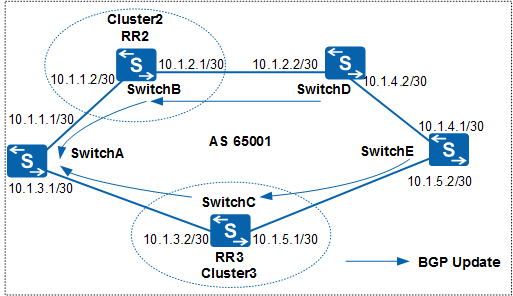Originator_ID
The Originator_ID attribute is four bytes long and is generated by an RR. It carries the router ID of the route originator in the local AS.
When a route is reflected by an RR for the first time, the RR adds the Originator_ID to this route. If a route already carries the Originator_ID attribute, the RR does not create a new one.
After receiving the route, a BGP speaker checks whether the Originator_ID is the same as its router ID. If Originator_ID is the same as its router ID, the BGP speaker discards this route.
The following example shows how Originator_ID is used during BGP route selection. In Figure 1, an IBGP peer relationship is established between each two neighboring devices in AS 65001. The router IDs of Switch B and Switch C are 2.2.2.9 and 3.3.3.9, respectively, and they function as RRs. Switch D is a client of Switch B, and Switch E is a client of Switch C. Switch D and Switch E are configured to import the route 10.1.4.0/30 to BGP.
Run the display bgp routing-table [ ip-address ] command on Switch A to check the configurations.
# Display the routing table of Switch A.
[HUAWEIA] display bgp routing-table
BGP Local router ID is 10.1.3.1
Status codes: * - valid, > - best, d - damped,
h - history, i - internal, s - suppressed, S - Stale
Origin : i - IGP, e - EGP, ? - incomplete
Total Number of Routes: 2
Network NextHop MED LocPrf PrefVal Path/Ogn
*>i 10.1.4.0/30 10.1.5.2 0 100 0 i
* i 10.1.2.2 0 100 0 i
The preceding command output shows that two routes 10.1.4.0/30 are available in the routing table of Switch A and that Switch A selects the route learned from Switch C.
[HUAWEIA] display bgp routing-table 1.1.1.9
BGP local router ID : 10.1.3.1 Local AS number : 65001 Paths: 2 available, 1 best, 1 select BGP routing table entry information of 10.1.4.0/30: From: 10.1.3.2 (3.3.3.9) Route Duration: 00h00m01s Relay IP Nexthop: 10.1.3.2 Relay IP Out-Interface: GigabitEthernet0/0/1 Original nexthop: 10.1.5.2 Qos information : 0x0 AS-path Nil, origin igp, MED 0, localpref 100, pref-val 0, valid, internal, best, select, pre 255, IGP cost 2 Originator: 10.1.4.1 Cluster list: 0.0.0.3 Not advertised to any peer yet BGP routing table entry information of 10.1.4.0/30: From: 10.1.1.2 (2.2.2.9) Route Duration: 00h00m17s Relay IP Nexthop: 10.1.1.2 Relay IP Out-Interface: GigabitEthernet0/0/0 Original nexthop: 10.1.2.2 Qos information : 0x0 AS-path Nil, origin igp, MED 0, localpref 100, pref-val 0, valid, internal, pre 255, IGP cost 2, not preferred for router ID Originator: 10.1.4.2 Cluster list: 0.0.0.2 Not advertised to any peer yet
The preceding command output shows that the route learned from Switch B is not selected due to a router ID issue. In fact, the router ID of Switch B is 2.2.2.9, smaller than that (3.3.3.9) of Switch C. The route learned from Switch B should be selected if the router IDs are used to determine the optimal route. However, the routes carry Originator_ID attributes. In this situation, the Originator_ID attributes (rather than router IDs) are compared. Switch A selects the route learned from Switch C because its Originator_ID (10.1.4.1) is smaller than that (10.1.4.2) of the route learned from Switch B.
Table 1 describes the attribute comparison of the routes learned from Switch B and Switch C.
Route Attribute |
Route Learned from Switch B |
Route Learned from Switch C |
Comparison |
|---|---|---|---|
PrefVal |
0 |
0 |
The same. |
Local_Pref |
100 |
100 |
The same. |
Route type |
Learned from a peer |
Learned from a peer |
The same. |
AIGP |
- |
- |
The same. |
AS_Path |
- |
- |
The same length. |
Origin |
IGP |
IGP |
The same. |
MED |
0 |
0 |
The same. |
Peer type |
IBGP |
IBGP |
The same. |
IGP cost |
2 |
2 |
The same. |
Cluster_List |
0.0.0.2 |
0.0.0.3 |
The same length. |
Originator_ID |
10.1.4.2 |
10.1.4.1 |
The route learned from Switch C is optimal. |
If routes carry Originator_ID attributes, the Originator_ID attributes (rather than router IDs) are compared.
